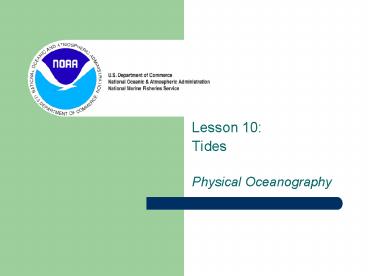Tides PowerPoint PPT Presentation
Title: Tides
1
- Lesson 10
- Tides
- Physical Oceanography
2
Last lesson we learned about waves
- How do you differentiate between a deepwater and
shallow-water wave? - What is the period of a wave?
3
Figure 1 Tide predictions for Dauphin Island,
3/1/11
Water Level (ft)
Time
4
Tides are also important physical forces in our
ocean
- Gravitational interactions between the sun, moon
and earth are the primary causes of tides - Different positions of the sun and moon create
two different types of tides spring tides and
neap tides - Tides play an important role in the life cycle of
many marine organisms
5
What is a tide?
- A tide is the periodic rise and fall of a body of
water due to gravitational interactions between
the sun, moon and Earth - The wavelength of an average tide can be up to
17,000 km (over 10,500 miles). Do you think tides
are deepwater or shallow water waves? - Shallow water! Recall that shallow-water waves
have Depth lt 1/20 Wavelength and deepwater waves
have Depth gt 1/2 Wavelength - The ocean would have to be deeper than 5,250
miles for an ocean tide to be a deepwater wave!
6
Tidal patterns vary around the world
- Some places have one low tide and one high tide
per day (diurnal tides) - Other places have two high and low tides per day
approximately equal in size (semidiurnal tides) - If the two high and low tides of a semidiurnal
tide are unequal in size, they are call mixed
semidiurnal tides - The US has examples of semidiurnal tides (East
Coast), diurnal tides (some areas of the Gulf of
Mexico) and mixed tides (Pacific Coast)
7
Tidal extremes The Bay of Fundy
- The Bay of Fundy in Canada is known for its
large tidal range (differences of over 50ft have
been recorded!)
Photo NASA
8
What causes tides?
- The gravitational pull of the sun and the moon
causes bulges on Earth that move as we rotate
9
What causes tides?
- The tide rises when coastline enters the bulge
and falls when it rotates out
10
Different types of tide
- Spring tides occur when the sun and moon are in a
straight line - The tidal range is typically highest during
spring tides
11
Different types of tide
Earth
- Neap tides occur when the sun and moon form a
right angle with Earth - Low tides are typically higher and high tides are
lower - Why is the moons pull greater than the suns?
Sun
Moon
12
Tides affect marine life
- Organisms that live near the shore have adapted
to the rise and fall of the tide - Well meet some of these creatures in todays
activity!
13
Tide exercise Can you identify the different
types of tides?
- You will be presented with three figures and
corresponding questions - See if you can determine which figures represent
diurnal, semidiurnal and mixed semidiurnal tides. - Good luck!
14
Figure 1 Tide predictions for Dauphin Island,
3/1/11
Water Level (ft)
Time
15
Figure 1 shows a diurnal tide one high and one
low tide
First hightide8pm
Water Level (ft)
First low tide8am
Time
16
Figure 2 Tide predictions for Woods Hole, MA,
8/25/10
Water Level (ft)
Time
17
Figure 2 shows a semidiurnal tide two high and
low tides of equal heights
First high tide9am
Secondhigh tide9pm
Tidal range2ft
Tidal range2ft
Water Level (ft)
Second low tide4pm
First low tide4am
Time
18
Figure 3 Tide predictions for Seattle, WA (Puget
Sound), 5/1/11
Water Level (ft)
Time
19
Figure 3 shows a mixed semidiurnal tide two high
and low tides of unequal heights
Second high tide6pm
First high tide4am
Tidal range4ft
Tidal range10ft
Secondlow tide11pm
Water Level (ft)
First low tide11am
Time
20
Student activity
- In todays activity, you will meet some marine
organisms that live in the intertidal zone the
area between the low tide water mark and high
tide water mark

